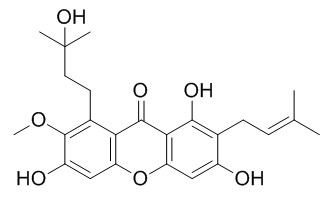Garcinone D
Garcinone D shows significant cytotoxicity against the CEM-SS cell line, with IC(50) value of 3.2 microg/ml; it exhibits dose-dependent enzyme-based microsomal aromatase inhibitory activity.
Garcinone D inhibits p65 activation with IC50 values of 3.2 microM.
Inquire / Order:
manager@chemfaces.com
Technical Inquiries:
service@chemfaces.com
Tel:
+86-27-84237783
Fax:
+86-27-84254680
Address:
1 Building, No. 83, CheCheng Rd., Wuhan Economic and Technological Development Zone, Wuhan, Hubei 430056, PRC
Providing storage is as stated on the product vial and the vial is kept tightly sealed, the product can be stored for up to
24 months(2-8C).
Wherever possible, you should prepare and use solutions on the same day. However, if you need to make up stock solutions in advance, we recommend that you store the solution as aliquots in tightly sealed vials at -20C. Generally, these will be useable for up to two weeks. Before use, and prior to opening the vial we recommend that you allow your product to equilibrate to room temperature for at least 1 hour.
Need more advice on solubility, usage and handling? Please email to: service@chemfaces.com
The packaging of the product may have turned upside down during transportation, resulting in the natural compounds adhering to the neck or cap of the vial. take the vial out of its packaging and gently shake to let the compounds fall to the bottom of the vial. for liquid products, centrifuge at 200-500 RPM to gather the liquid at the bottom of the vial. try to avoid loss or contamination during handling.
Molecules.2019, 24(12):E2286
Front Plant Sci.2020, 11:630.
Acta Chromatographica2021, 00960.
The Journal of Internal Korean Medicine2015, 36(4):486-497
J Ethnopharmacol.2024, 318:116863.
J Pharmaceutical Research Int.2021, 33(41A):275-284.
Nat Commun.2019, 10(1):5169
Saudi Pharmaceutical Journal2023, 31(12):101829
Acta Pharm Sin B.2015, 5(4):323-9.
Nutr Res Pract.2023, 17(4):670-681.
Related and Featured Products
J Asian Nat Prod Res. 2008 May-Jun;10(5-6):475-9.
Garcinia mangostana: a source of potential anti-cancer lead compounds against CEM-SS cell line.[Pubmed:
18464091]
METHODS AND RESULTS:
Meanwhile, the root bark of the plant furnished six xanthones, namely alpha-mangostin (2), beta-mangostin (3), gamma-mangostin (4), Garcinone D (5), mangostanol (6), and gartanin (7). The hexane and chloroform extracts of the root bark of G. mangostana as well as the hexane extract of the stem bark were found to be active against the CEM-SS cell line. gamma-Mangostin (4) showed good activity with a very low IC(50) value of 4.7 microg/ml, while alpha-mangostin (2), mangostanol (6), and Garcinone D (5) showed significant activities with IC(50) values of 5.5, 9.6, and 3.2 microg/ml, respectively.
CONCLUSIONS:
This is the first report on the cytotoxicity of the extracts of the stem and root bark of G. mangostana and of alpha-mangostin, mangostanol, and Garcinone D against the CEM-SS cell line.
J Nat Prod. 2008 Jul;71(7):1161-6.
Xanthones from the botanical dietary supplement mangosteen (Garcinia mangostana) with aromatase inhibitory activity.[Pubmed:
18558747]
Twelve xanthone constituents of the botanical dietary supplement mangosteen (the pericarp of Garcinia mangostana) were screened using a noncellular, enzyme-based microsomal aromatase inhibition assay.
METHODS AND RESULTS:
Of these compounds, Garcinone D (3), garcinone E (5), alpha-mangostin (8), and gamma-mangostin (9) exhibited dose-dependent inhibitory activity. In a follow-up cell-based assay using SK-BR-3 breast cancer cells that express high levels of aromatase, the most potent of these four xanthones was gamma-mangostin (9).
CONCLUSIONS:
Because xanthones may be consumed in substantial amounts from commercially available mangosteen products, the consequences of frequent intake of mangosteen botanical dietary supplements require further investigation to determine their possible role in breast cancer chemoprevention.
J Nat Prod. 2009 Nov;72(11):2028-31.
Cytotoxic xanthone constituents of the stem bark of Garcinia mangostana (mangosteen).[Pubmed:
19839614 ]
METHODS AND RESULTS:
11-hydroxy-3-O-methyl-1-isomangostin (1). The structure of 1 was elucidated by spectroscopic data analysis. In addition, 10 other known compounds, 11-hydroxy-1-isomangostin (2), 11alpha-mangostanin (3), 3-isomangostin (4), alpha-mangostin (5), beta-mangostin (6), Garcinone D (7), 9-hydroxycalabaxanthone (8), 8-deoxygartanin (9), gartanin (10), and cratoxyxanthone (11), were isolated. Compounds 4-8 exhibited cytotoxicity against the HT-29 cell line with ED50 values of 4.9, 1.7, 1.7, 2.3, and 9.1 microM, respectively. In an ELISA NF-kappaB assay, compounds 5-7, 9, and 10 inhibited p65 activation with IC50 values of 15.9, 12.1, 3.2, 11.3, and 19.0 microM, respectively, and 6 showed p50 inhibitory activity with an IC50 value of 7.5 microM.
CONCLUSIONS:
Alpha-mangostin (5) was further tested in an in vivo hollow fiber assay, using HT-29, LNCaP, and MCF-7 cells, but it was found to be inactive at the highest dose tested (20 mg/kg).



